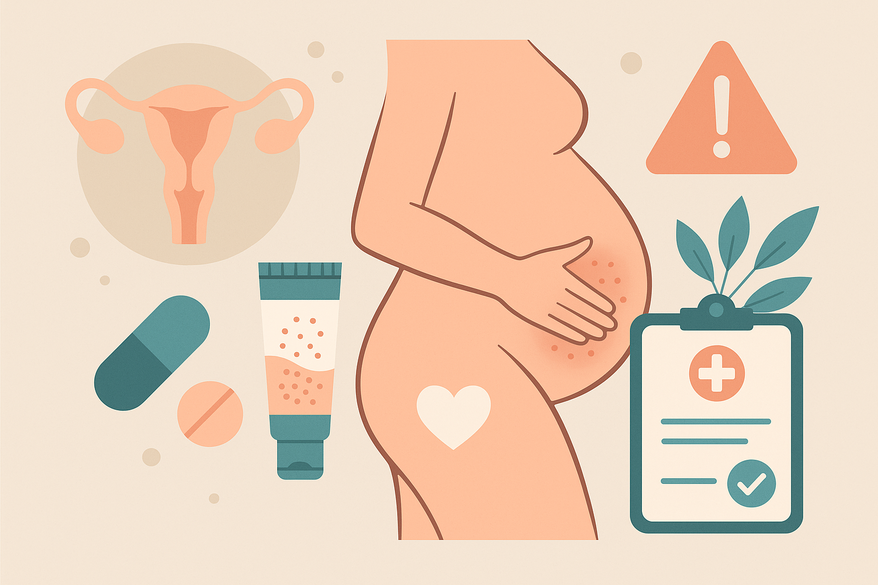Pregnancy Rash Causes: Essential Insights for Expectant Mothers
Explore pregnancy rash causes, from hormonal changes to serious conditions. Learn how to manage symptoms and know when to seek medical advice.

Estimated reading time: 8 minutes
Key Takeaways
- Pregnancy rashes differ from benign skin changes and often involve itching and new lesions.
- Common triggers include hormonal shifts, allergic reactions, and underlying conditions like PUPPP or ICP.
- Gentle skincare, avoiding irritants, and lifestyle adjustments can prevent or reduce symptoms.
- Severe itching or systemic signs require prompt medical evaluation to protect mother and baby.
Table of Contents
- Understanding Pregnancy Rashes
- Common Causes of Rashes During Pregnancy
- How Physiological Changes Lead to Rashes
- Managing and Preventing Rashes
- When to Seek Medical Advice
- Conclusion
Understanding Pregnancy Rashes
A pregnancy rash describes any new skin eruption—red bumps, intense itching, or hive-like patches—that goes beyond normal changes such as stretch marks or linea nigra. Clinically, these are known as pregnancy dermatoses.
Key distinctions:
- Benign changes: hyperpigmentation, linea nigra, or striae gravidarum (stretch marks).
- Pregnancy rashes: new red or raised lesions often accompanied by pruritus (itchiness).
Most dermatoses emerge in the third trimester but can appear at any stage. Early recognition allows better symptom control and rule-out of serious conditions.
Common Causes of Rashes During Pregnancy
Hormonal Changes
Fluctuating estrogen and progesterone levels can:
- Increase skin sensitivity.
- Promote water retention in skin layers.
- Trigger generalized itching.
Allergic Reactions
Immune modulation may provoke contact allergies. Common culprits include:
- Fragranced skincare or makeup.
- Certain fabrics (wool, synthetic blends).
- Laundry detergents with dyes or enzymes.
Underlying Conditions
- Eczema: atopic dermatitis flare-ups due to immune shifts.
- PUPPP (Pruritic Urticarial Papules and Plaques of Pregnancy): hive-like patches on stretch marks, usually in the third trimester.
- ICP (Intrahepatic Cholestasis of Pregnancy): intense itching on palms and soles, often without visible rash.
- Rare dermatoses: atopic eruption of pregnancy, pemphigoid gestationis, or impetigo herpetiformis.
Other Triggers
- Dietary changes or prenatal vitamins.
- New medications (antibiotics, antacids).
- Heat rash and hives due to increased circulation and body temperature.
How Physiological Changes Lead to Rashes
Immune System Adjustments
Pregnancy shifts immunity from Th1 (cell-mediated) to Th2 (antibody-mediated), which:
- May trigger inflammatory skin reactions.
- Can worsen autoimmune or atopic conditions.
Circulatory & Fluid Changes
- Blood volume rises by 30–50%, increasing skin perfusion.
- Fluid retention stretches the skin, leading to edema and itching.
Genetic & Environmental Predispositions
- Family history of eczema, psoriasis, or other dermatoses raises risk.
- Heat, humidity, and allergen exposure can exacerbate symptoms.
Managing and Preventing Rashes
Skincare Recommendations
- Use gentle, fragrance-free cleansers.
- Moisturize daily with emollients rich in ceramides or colloidal oatmeal. For specific products, see Top Fragrance-Free Moisturizer Suggestions.
- Avoid hot showers and harsh soaps that strip natural oils.
Minimizing Irritants
- Wear breathable, moisture-wicking fabrics.
- Switch to hypoallergenic, dye-free detergents.
- Patch-test any new skincare or cosmetic product.
Lifestyle Adjustments
- Stay well-hydrated to support the skin barrier.
- Opt for loose-fitting clothing to reduce friction.
- Practice stress management through prenatal yoga or meditation.
- Cool compresses or oatmeal baths can relieve acute itching.
Additionally, for personalized rash insights, Rash Detector uses AI to analyze your rash photos and deliver instant reports.

Medical Interventions
- Over-the-counter: colloidal oatmeal lotions and doctor-approved antihistamines.
- Prescription: low- to mid-potency corticosteroids or UVB phototherapy.
- Severe cases (PUPPP, ICP) may require specialist referral and systemic treatments.
When to Seek Medical Advice
Red flag symptoms:
- Persistent itching on palms or soles.
- Rash with blisters, ulcers, or spreading plaques.
- Systemic signs like fever, malaise, or joint pain.
- Jaundice indicating possible ICP.
History to share with your provider:
- Onset, progression, and distribution of the rash.
- Itching intensity, pain, or other associated symptoms.
- Recent changes in products, medications, or supplements.
Early diagnosis and treatment improve outcomes. Contact your OB/GYN or dermatologist if you notice any warning signs.
Conclusion
Pregnancy rash causes range from harmless hormonal shifts to serious conditions like PUPPP and ICP. Gentle skincare routines, minimizing irritants, and lifestyle adjustments can prevent or ease many rashes. However, severe itching—especially on palms and soles—or systemic symptoms warrant prompt medical evaluation. Share your experiences or questions in the comments below to support fellow expecting mothers.
FAQ
- Can pregnancy rashes harm my baby?
Most pregnancy‐related rashes are benign and do not affect fetal health. Conditions like ICP require medical oversight due to increased risks.
- Are there safe over-the-counter treatments?
Yes. Colloidal oatmeal products and doctor-approved antihistamines are generally considered safe. Always check with your provider.
- How can I distinguish normal skin changes from a rash?
Normal changes include stretch marks and hyperpigmentation without itching. New, itchy, red, or raised lesions indicate a rash.
- When should I see a specialist?
If you experience severe itching, systemic symptoms, or signs of ICP like jaundice, consult your OB/GYN or a dermatologist immediately.





